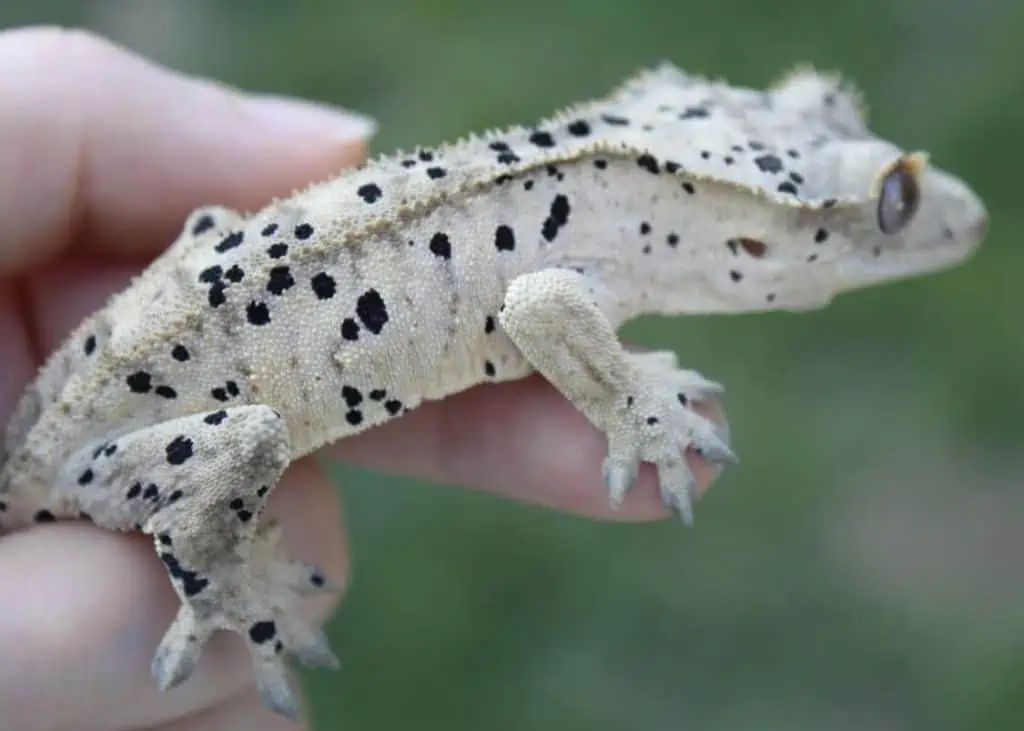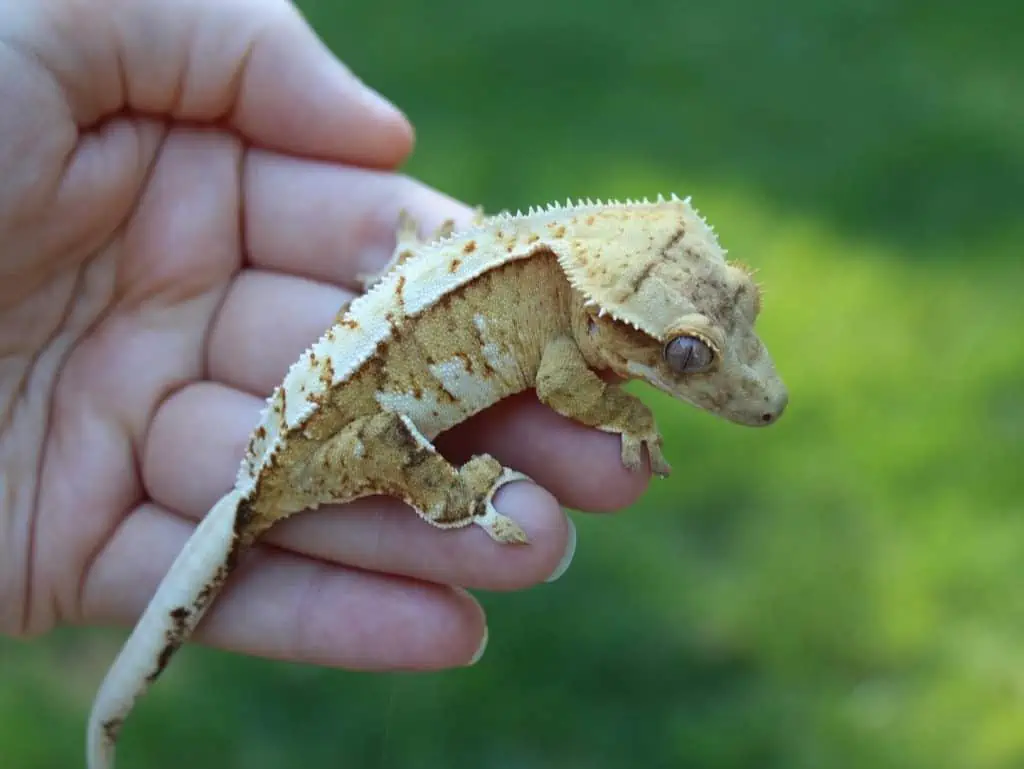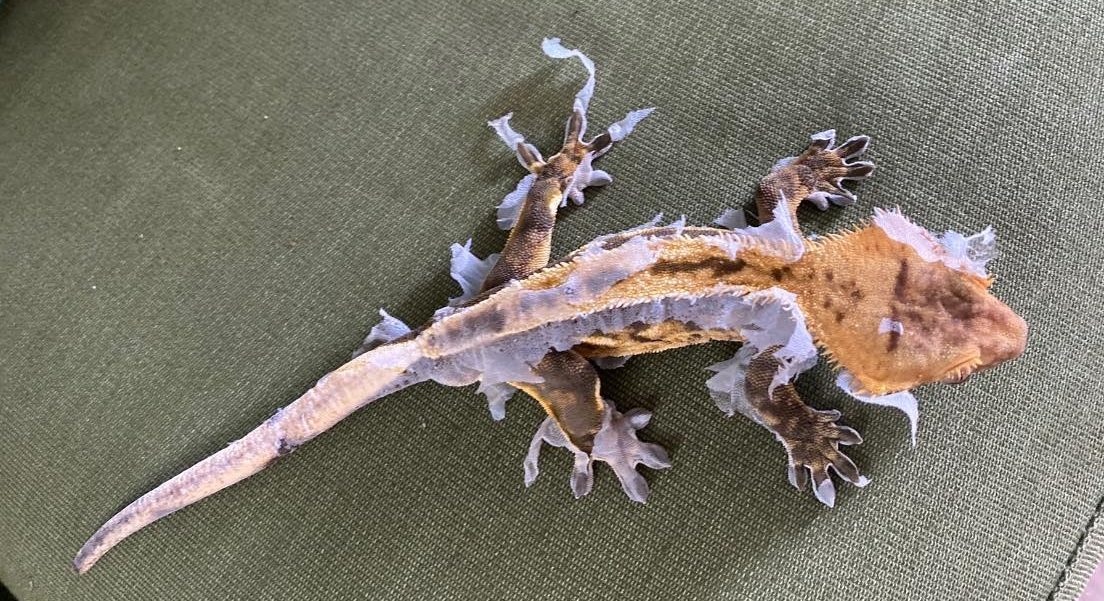Shedding, scientifically known as ecdysis, is a necessary natural process that occurs periodically in all reptiles, including crested geckos. It allows them to replace their old skin with fresh one to accommodate the increasing body mass. The frequency of shedding depends on factors such as
- Growth rate
- Gender
- Illness
- Nutrition
- Environmental conditions
Generally, with crested geckos, babies shed more frequently than adults due to their ongoing growth. Monitoring the shedding process and ensuring it proceeds smoothly to prevent complications is crucial.
Although shedding is normal, problems can arise due to improper diet or environmental conditions. Detecting and addressing these issues early can prevent complications.
Let’s dive into the fascinating world of crested gecko shedding and discover the key insights that will empower you to support your buddy gecko throughout this transformative process.
Why Do Crested Geckos Shed?
Crested geckos naturally shed their skin as they grow and mature to make room for their larger size. This shedding occurs throughout your little monster’s life because its old skin is too tight and limits movement.
Not only does this help them move better, but it also gets rid of parasites like mites that may have latched on to their skin.
Plus, it can help heal any injuries or abnormalities they may have had. Successful shedding is a sign of good health in these geckos. You know your crested friend is doing well if they shed their skin in one piece. If not, it could indicate they’re dehydrated, stressed, or having other health issues. 😮
So watch out for that! Taking care of your reptilian friends is important if you want them to stay healthy.

How To Tell When Your Crested Gecko Is About To Shed
You can identify that your scaly friend is about to shed when you observe its old, dead skin peeling off. Additionally, other indications suggest your crestie is prepared for the skin-shedding process.
1. Change in Skin Color
The 1st sign of the shedding process for a crestie is the change in skin color. Usually, crested geckos turn a different color when they’re about to shed. They may appear grey, paler, or ashy. Sometimes, their skin may darken.
The gray areas may be in patches or cover entire body parts, such as the head or legs. This is because the old skin becomes transparent as it separates from the new. You may not see the detailed markings your gecko once had (though they will reappear after the gecko sheds).
2. Sticking Problems
Crested geckos may have trouble sticking to surfaces when they are about to shed. This occurs because the old, dry skin makes it difficult for them to climb walls or hold onto objects. This sign is usually accompanied by dullness and dryness.
3. Dry Skin
Their skin may get drier and looser as it prepares to fall off. It may look dry, or you may notice that it feels dry. You may also see thin, white lines or patches on your gecko’s skin. These are caused by calcium deposits built up beneath the old skin, which will be shed off.
4. Rubbing Against Objects
Another sign of an upcoming shed is your gecko rubbing against objects inside its enclosure. This behavior resembles itching, as your friend’s gecko may feel uncomfortable.
It may rub against the walls of its cage, perches or branches, or even furniture and decorations. This behavior may be more prominent when you’re asleep at night.
5. Loss of Appetite and Decreased Activity
During this time, your crested gecko will likely start to eat less and become less active. The gecko will be using most of its energy to shed, so it will not waste energy by hunting or being active. You may also notice your gecko spending much time in its hiding spot.
6. Dulled Eyes
Crested geckos often have dulled eyes before shedding. The eye caps will look cloudy or dull as the old skin loosens. The eyes may also appear sunken into the head instead of protruding.
7. Swollen Skin
You may also notice the skin on your reptile’s body becoming swollen. This is because the old skin can’t stretch anymore and starts to feel taut, making it bulge out from the gecko’s body. This doesn’t hurt your gecko, it just means that it needs to shed.
Shedding Process in Crested Geckos
Crested geckos shed their skin in a process called ecdysis. This natural process is triggered by the growth of new skin cells, which causes the old skin to separate from the body. The skin of a crested gecko consists of two layers: the dermis and the epidermis.
- The epidermis is the top layer and constantly produces new cells that fill with keratin, a protein that provides protection and prevents water loss.
- Once the skin cells are fully grown and filled, they die. The dead skin layer needs to be replaced with new skin. The old layer begins to loosen and separate from the underlying layers, and it comes off as a complete layer, unlike our skin cells.
- To help the old skin come off, your crested pal will rub against objects like branches or rocks in its enclosure. It may also use its mouth and tongue to peel off the entire layer.
- Once the shedding is complete, the new skin underneath will harden and darken over a few days. To ensure the process goes smoothly, giving your gecko companion a comfortable and supportive environment during this time is important.
At What Age Do Crested Geckos Shed?
Crested geckos start shedding their skin from a young age, usually within the first few weeks of hatching.
After emerging from their egg, newly hatched crested geckos will not eat until after they have shed and eaten their first skin. During this period, your lizard pet relies on the nutrients and energy supplied by its yolk sack for sustenance.
As it ages, crested geckos shed their skin regularly, usually every four to six weeks.
Shedding Frequency of Crested Geckos
The shedding frequency of your pet gecko is linked to its growth and is more frequent when the gecko is younger.
Hatchling geckos will shed more frequently than juveniles and more often than adults.
- Hatchlings usually shed weekly
- Juvenile geckos shed every 2-3 weeks
- While adult geckos may shed every 3-4 weeks
As crested geckos approach 3-4 years of age, their growth rate slows and may only shed once a month.
The shedding frequency of your crested gecko will vary depending on its growth rate, as each crested gecko is unique.
Refer to the table below to get an estimate of shedding frequency.
| Crested Gecko’s Age | Shedding Frequency |
| Hatchling | Weekly |
| Juvenile (6 months to 1 year) | Every 2-3 Weeks |
| Adult (1-2 years) | Every 3-4 Weeks |
| Above 2 years | Every 4-5 Weeks |
Other Factors That Affect Shedding Frequency
In addition to growth, other factors may influence how often your scaly friend will shed.
- Gender: Male and female cresties grow at different rates, with males being generally larger and growing faster. Consequently, male geckos may shed more frequently as juveniles and throughout adulthood.
- Environmental Conditions: The shedding frequency of a crested gecko is influenced by temperature and humidity. Maintain the ideal conditions to ensure that the gecko sheds the appropriate amount. If the enclosure lacks humidity, the gecko may not shed as often as necessary, resulting in health issues.
- Illnesses: Certain illnesses can impact the shedding frequency of geckos. Adult geckos may shed to manage external parasites, so if your gecko is infected, it could shed more frequently.
- Nutrition: Proper nutrition is essential for crested geckos to grow as expected and shed regularly. If they lack proper nutrition, they may not need to shed as much and may experience stunted growth.

How Long Does It Take for a Crested Gecko To Finish Shedding?
It’s no secret that shedding can be a hassle, even for crested geckos! The time it takes for a crestie to shed its skin can vary, usually at least 15-30 minutes, but sometimes lasting for hours or even a few days.
It all depends on a few factors, like:
- The size of your gecko
- The age of your gecko
- The humidity level in its enclosure
- Its overall-health
Generally, smaller and younger geckos shed quicker, as they don’t have a lot of skin to slough off. On the other hand, healthy geckos in a well-maintained environment will usually shed their skin quicker than those that are stressed or unhealthy.
So, if you want your crested gecko to do a quick shed, ensure it’s properly handled!
Shedding Problems With Crested Geckos
While shedding is typically not an issue for most cresties occasionally, they may experience shedding problems that can vary in severity. Below, I’ve summarized some of the common shedding problems that may occur.
Dysecdysis, Retained Skin, or Stuck Shed
A stuck shed, dysecdysis, happens when a crested gecko’s old skin is not fully removed. It is the most common shedding problem that your gecko may experience. It can lead to mobility issues and cause discomfort for the lizard. Left untreated, it can lead to severe infections or other health issues.
For instance, a stuck shed between a crestie’s toes may restrict blood circulation and cause necrosis (tissue death). This could require surgery and even amputation of the affected limb!
Similarly, stuck shed on your crestie’s tail may result in the lizard dropping it all together; although this is harmless, the tail won’t grow back.
Lastly, stuck sheds on the eyes can cause infection, blindness, or anorexia due to bacteria build-up. 🙁
Shedding Difficulty
Sometimes, a crested gecko may have difficulty shedding due to low humidity levels or other health issues such as dehydration.
- Low humidity can dry the skin, making it more difficult for your gecko to shed off its old skin.
- Similarly, dehydration can cause the skin to become dry and brittle, making it harder for the crestie to shed off its old skin.
Shedding in Patches
In some cases, your buddy geckos may experience shedding in patches. This is when the skin doesn’t come off in one piece but in several smaller pieces. This may be due to low humidity or a crested gecko not receiving the proper care and nutrition.
Treatment Options for Shedding Problems
While it’s recommended that you don’t handle your scaly companion during shedding. If your gecko is having difficulty shedding and cannot remove old skin, you can lend a helping hand. Here’s what you can do:
Massage Your Crested Gecko
Removing a stuck shed from a crested gecko is best to gently rub the affected area with a warm and damp cloth. You can also grab a soft-bristled toothbrush or Q-tip to help you out.
Just ensure the process is gentle, as it’d be easy to damage the gecko’s delicate skin with something sharp or rough.
And don’t even think about pulling off the skin with your fingers; that could easily lead to open wounds and skin infections!
Provide a Sauna
You can offer a ‘sauna’ to your lizard by filling a small tub or container with paper towels soaked in lukewarm water. Don’t make it too hot, never above 85°F – as crested geckos are cold-blooded and can suffer heat stroke.
Let your gecko soak for 15-30 minutes, and then gently try to remove the old skin with a swab. If it doesn’t come off easily, you can use a special spray from Zoo Med to make things easier.
Don’t force it off, though, as this can cause more harm than good. Let your gecko soak a bit longer if necessary, or soak it multiple times until the skin comes away with a gentle push. It might take some time, but it’ll be worth it in the end!
Increase the Humidity
Inadequate hydration and low humidity levels are common causes of shedding problems. If your small reptilian friend has difficulty removing its old skin, it’s time to up the humidity!
Try increasing the level to 80-90% during the shedding period. Remember to ensure proper ventilation. The added moisture will help soften the skin, making it easier to shed.
Visit Your Vet
If your crested gecko still has a shedding problem after trying the above methods, it might be time to visit your vet.
He or she will be able to examine your gecko and know what to do to help your gecko shed without any problems.

Can You Hold a Crested Gecko While It’s Shedding?
When your gecko is shedding, giving them some space is best. It is not recommended to hold them during that time because:
- Shedding is quite uncomfortable for these little fellas. They can handle it independently, but you might add some stress to the mix if you invade their turf. And trust me, that’s no good. Stress can mess up their shedding process, resulting in a stuck shed.
- If you hold your crestie during shedding, you might accidentally peel off its old skin before it’s ready to come off. And that can cause serious harm, messing up the new skin underneath and disrupting the whole shedding process. Even if it looks like the skin is about to come off, I advise you to resist the urge to touch unless you know it’s a stuck shed.
Things To Do To Help Your Crested Gecko During Shedding
To help your little gecko shed its skin smoothly and stay healthy, I recommend you follow these tips:
- Maintain humidity above 50%, preferably between 60-80%.
- Create a moist box or use premade ones to boost humidity.
- Choose moisture-retaining substrates like coconut husk or sphagnum moss.
- Provide abrasive surfaces such as branches or cork bark for easier skin removal.
- Minimize handling during shedding to reduce stress.
- Remove any uneaten food to prevent bacterial growth.
- Keep a close eye on any shedding issues and seek vet assistance if needed.
Take Care!
Understanding the shedding process of your little gecko is crucial to ensuring its health and well-being. You can support your gecko through this natural process by recognizing the signs of shedding, providing the right conditions, and offering gentle assistance when needed.
Remember to maintain proper humidity levels and provide appropriate hiding spots for your gecko during shedding.
Regularly inspect their eyes, toes, and tail for any stuck shed and seek your vet’s assistance when needed.
Have you encountered challenges with your gecko’s shedding? Do you have any tips to share? Share your thoughts in the comments below.


